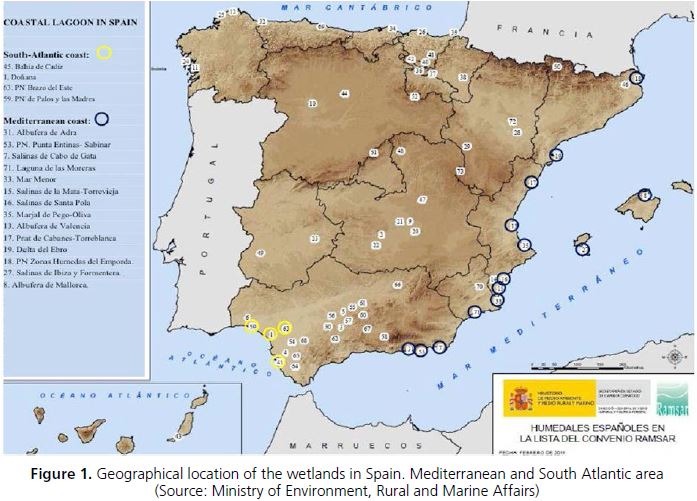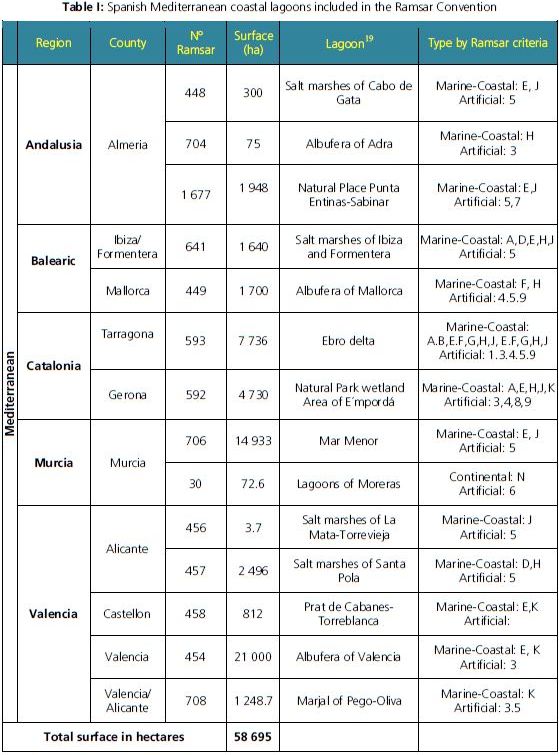9.2 General information on coastal lagoons
There are fourteen coastal lagoons in the Mediterranean coast of Spain, for a total surface of 58 695 ha18. In addition to these coastal lagoons, two other coastal lagoons from the south Atlantic coast of Spain should be added, due to their fisheries and aquaculture activity. It is important to highlight that all Mediterranean coastal lagoons in Spain are wetlands listed as Ramsar sites.
In the last century, the wetlands in Spain have undergone a major regression in size and environmental quality. It is estimated that 60 percent of Spanish wetlands have disappeared in the last 40 years (Ministerio de Agricultura, Alimentacion y Medio Ambiente, 2000). As a result, the SSPW is an instrument for the coordination and control of different actions for the conservation of these ecosystems:
a) Guarantee the conservation and wise use of wetlands;
b) Integrate conservation and wise use of wetlands in sectoral policies (water, coastal, land use, forestry, agriculture, fisheries, etc.);
c) Contribute to the fulfillment of the agreements, directives, policies and European and international agreements associated to wetlands.
The Strategic Plan highlights the need to develop and keep an updated Spanish inventory of wetlands to improve the knowledge on these and enhance the conservation of biodiversity. In 2004, the Spanish Government published the Spanish Inventory of Wetlands, where 237 wetlands covering an area of 164 493 ha were identified (Ministerio de Agricultura, Alimentacion y Medio Ambiente, 2000).
Inventory data show that most Spanish wetlands are inland waters (92 percent), although they do not reach 14 percent of the total surface. Coastal wetlands occupy 86 percent of the total area, notably: the marshes of the Guadalquivir, the Bay of Cadiz, the Ebro delta, the Mar Menor, the Albufera of Valencia and the marshes of the Emporda. This inventory includes coastal lagoons, but the Murcia and Catalonia regions, where there are significant wetlands and lagoons areas, are not considered.
As a complement, Spanish Mediterranean regions have their respective inventories or catalogs of wetlands, which are:
Region of Andalusia: Inventory of Wetlands of Andalusia (Junta de Andalucia, 2004). Region of Murcia: Wetlands and Ramblas in the Region of Murcia (Comunidad Autonoma de la Region de Murcia, 2003).
Region of Valencia: Catalog of Wetlands of Valencia (Generalitat Valenciana, 2002). Region Catalonia: Inventory of Wetlands of Catalonia (Generalitat de Catalunya, 2005). Region of Balearic Islands: Technical Report to characterization, classification and inventory of Wetlands in Balearic Island (Govern de les Illes Balears, 2007).
The coastal lagoons present in the Spanish regions of Andalusia, Murcia, Valencia, Catalonia and the Balearics are analyzed hereafter.
18 This surface has been calculated from data extracted from the sheets of each Ramsar site. In some cases such as the Ebro delta, this area is not the same as the water surface of lagoons, and therefore, the total area of the Mediterranean coastal lagoons in Spain could be less.
Spanish coastal lagoons develop diverse activities, among which are fisheries, shellfish and aquaculture. Estuaries, deltas, lagoons and other coastal wetlands provide protected habitats rich in nutrients that fish use as spawning, nursery or habitat areas.
In the next figure are shown all the coastal lagoons in the Mediterranean coast and some in the south Atlantic coast, included in the Ramsar list in Spain by the Ministry of Environment, Rural and Marine Affairs.

Figure 1. Geographical location of the wetlands in Spain. Mediterranean and South Atlantic area (Source: Ministry of Environment, Rural and Marine Affairs)
The following table shows Mediterranean Spanish coastal lagoons, by geographic area and by county and region, included in the Ramsar list.
Table I: Spanish Mediterranean coastal lagoons included in the Ramsar Convention

19 Some of these coastal lagoons are individual and others areas such as the Ebro delta, where there are eight lagoons on site, include other lagoons. Therefore, the number of lagoons could be larger, but this has been adopted as a criteria.
Table II: Spanish South Atlantic coastal lagoons included in the Ramsar Convention

* Near this wetland and within PN Donana is located “Veta la Palma”, considered in the context of this report as an example of management and ecological value.
Legal framework
At the State level, there are different legal and strategic instruments that establish the importance of wetlands (and coastal lagoons) and the need for conservation.
Water Law 29/1985 establishes a definition of wetland, the need for inventory and delineation, development of management plans, inclusion in the public inland waters (both surface and groundwater), natural channels, the beds of lakes and reservoirs and underground aquifers, and provides for the protection, restoration and wetland creation.
Law 4/1989 on Conservation of Natural Areas and Wildlife also provides for the establishment of a national inventory of wetlands with protective measures in the river basin. Coastal Law 22/1988 aims at the identification, protection, use and policing of maritime-terrestrial domain and especially the seashore.
Among the strategic and planning instruments with an implication on wetlands are the future National Hydrological Plan and the National Irrigation Plan, the various Basin Water Plans, the National Forest Strategy, the Spanish Strategy for the Conservation and Sustainable Use Biological Diversity and the White Paper on Environmental Education in Spain (Ministerio de Agricultura, Alimentacion y Medio Ambiente, 2000).
At the regional level, there are numerous instruments and initiatives for the conservation and wise use of wetlands, incidence variable by region. Among them are many legal rules that consider wetlands protection.In addition, several regions developed or are developing wetland inventories or catalogs, as is the case of Andalusia, the Balearic Islands, Castilla and Leon, Castilla-La Mancha, Catalonia, Extremadura, Galicia, Madrid, Murcia, Navarra, Basque Country and Valencia.
In the Spanish Mediterranean area, within the framework of the Barcelona Convention and the Action Plan for the Mediterranean (MAP), the Protocol Concerning Specially Protected Areas and Biological Diversity in the Mediterranean was adopted in 1995, which establishes the need for special protection measures for endangered animals and plants in the Mediterranean, as well as of areas considered vital to their survival.
Moreover, the Specially Protected Areas of Mediterranean Importance (SPAMI) was created to ensure the protection of, inter alia, the coastal areas of high ecological importance and those that contain representative ecosystems, including several coastal wetlands. The Resolution of Barcelona for the Environment and Sustainable Development in the Mediterranean Basin was adopted in 1995 as a tool for implementing the second phase of the MAP, the Barcelona Convention and its Protocols.
178
Most of the information reported below is derived from data of some Mediterranean coastal lagoons selected as case studies, for the presence of fishing activities or aquaculture in them and in addition, two lagoons located on the Atlantic area but with an obvious Mediterranean climatic influence were included.
The origin, typology and characteristics of Spanish lagoons are very diverse, and in some cases, these lagoons are coastal ecosystems where water management has created a privileged habitat from an ecological and environmental viewpoint.
Spanish lagoons on the Mediterranean climatic influence zone are extensive areas of tidal influence where the transformation and land management has led to the permanent flooding of the space, creating lagoon systems of great ecological value.
In the other side, several small and medium coastal lagoons areas are found along the Mediterranean Spanish coast, from the French border down to the Atlantic limit in the southwest, and have different typology, uses and human activities interrelation.
From Atlantic lagoons to the Ebro delta lagoons, located in the north Mediterranean coast of Spain, all are influenced by the Mediterranean climate. Only the existence of tides gives different characteristics to the Atlantic coastal lagoons. So, in Mediterranean lagoons, tides are typically small, with amplitudes of up to 30 cm, which undoubtedly means that the renewal and flood capacity of the lagoons is low and depends on other meteorological factors, such as heavy rains
and storms (Ramsar, 2012).
The capacity of water renewal is normally managed by gates that store water in the rise of tides, and water retained or disposed of in the fall of the tide. The existence of this phenomenon undoubtedly contributes to greater biological richness and a greater potential for the exploitation of aquatic resources.
All Spanish lagoons show a great richness and diversity, and provide foraging and shelter for birds, making these ecosystems increase their ecological value.
In Spain, all coastal lagoons are protected by some environmental “protection scheme”, with a different level of activities allowed. Strong modifications and the intervention of human activities along the Spanish coasts partly explain why there is a relatively low number of lagoons.
Regarding the geomorphology of the coast, the Atlantic sector is characterized by a low gradient continental platform, with large areas of wetlands and large rivers flowing into the sea, while the Mediterranean area is characterized by a steeper sloping platform, a coastline with low presence of large rivers and estuaries and some coastal lagoons, Albuferas and the Ebro delta, as is illustrated in the previous geographical table.
With regards to the extension of the case studies areas, two magnitudes should be taken into consideration: on the one hand the surface of the protected areas as a whole and on the other hand the extent of the lagoon within them. In most cases, lagoons are usually a small part within protected areas.
In general terms, the surface of the Spanish lagoons is very small, ranging from the 235 acres of some lagoons in the delta del Ebro, to 15 000 ha of the Mar Menor. Except for the Donana wetland, which has a larger surface area, the average remaining lagoons is approximately 4 355 ha (Ramsar, 2012).
Regarding the origin or entry of water in the lagoons, almost all tend to have freshwater input and other inputs from salt or brackish water. The percentage of each of these, i.e., the quantity and quality of water, is usually related to water management systems. Water features are related to the origin of water sources in the lagoons. In general, the type of water in the lagoon is mixed, and the degree of dominance will be related to rainfall, storms and to hydrology. The lagoons physical characteristics will depend ultimately on the use and management, and there is a direct relationship between the use for aquaculture and fisheries and the water state of conservation of it.
179
The presence of an important fish community should be linked to good conditions for aquatic life and the existence of fishing activity somehow reflects the health of the lagoons. In general, the lagoons receive inputs of freshwater usually from rivers and sea inputs.
Depth depends on the lagoon type, hence in areas such as Atlantic lagoons where there was a transformation of land for the development of aquaculture, the average depth is around 1m, while the depth in lagoons of the Ebro delta or Albuferas is minimal, ranging of 30-50 cm. Mar Menor is the deepest lagoon because in reality it is a bucket of geological origin, and so has distinct hydrological and environmental conditions (Ramsar, 2012).
Salinity varies according to the amount of seawater received annually. However, salinity ranges are much higher in shallower as the "Albufera" or the delta lagoons. In general, lagoons in the Mediterranean have higher values of salinity as a consequence of lower depth and more evaporation.
The connection with the sea in the coastal lagoons is essential for the water renewal and the entire lagoon ecosystem. In those lagoons where the connection with the sea is greater, the amount and diversity of aquatic resources is bigger too.
All lagoons are connected with the sea. Regarding drainage water, all collected water runoff and some aquifers are located around the lagoons; the level of this contribution is closely related to the annual rainfalls and the presence of aquifers.